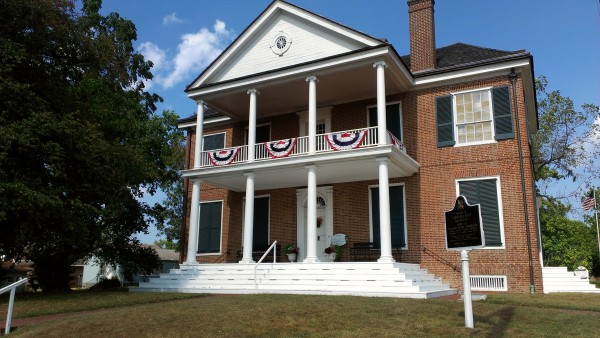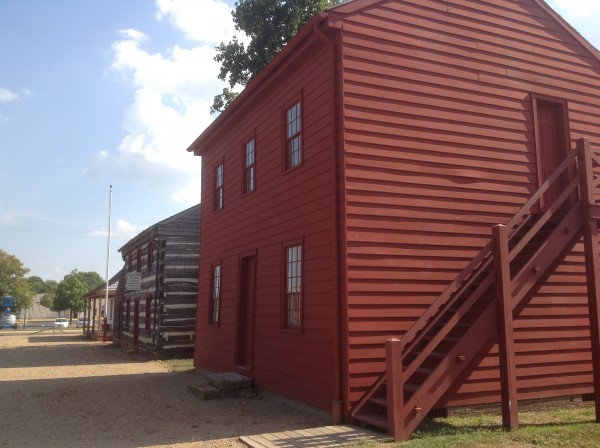‘Indiana at 200’ — William Henry Harrison Shaped Indiana from Vincennes
 EDITORS NOTE: This is the start of a series of essays leading up to the celebration of the Indiana Bicentennial In December 2016. The essays focus on the top 100 events, ideas and historical figures of Indiana, in chronological order, tying each to a place or current event in Indiana that continues to tell the story of the state.
EDITORS NOTE: This is the start of a series of essays leading up to the celebration of the Indiana Bicentennial In December 2016. The essays focus on the top 100 events, ideas and historical figures of Indiana, in chronological order, tying each to a place or current event in Indiana that continues to tell the story of the state.
By ANDREA NEAL
In the history books, William Henry Harrison was the first president to die in office, but Hoosiers should remember him as the man who shaped the Indiana Territory.
Indiana was a territory for 16 years before it became a full-fledged state. Following a multi-step process set out in the Northwest Ordinance, citizens first had to get practice in governing, grow in population, petition for statehood, be accepted into the union and write a constitution.
 Like a conductor directing an orchestra, Harrison oversaw much of the process from his governor’s mansion in Vincennes, the territorial capital chosen because it had a sizable population and was conveniently located on the Wabash River. In the process, he negotiated 10 treaties with Native Americans, bringing the land firmly under U.S. control.
Like a conductor directing an orchestra, Harrison oversaw much of the process from his governor’s mansion in Vincennes, the territorial capital chosen because it had a sizable population and was conveniently located on the Wabash River. In the process, he negotiated 10 treaties with Native Americans, bringing the land firmly under U.S. control.
The Indiana Territory was much larger than what became Indiana. Carved out of the Northwest Territory in 1800, it included Indiana, Illinois, Wisconsin and parts of Minnesota and Michigan. At the time, some 12,000 Native Americans and 6,000 settlers lived there. By 1816, Indiana had been whittled down to its current size and had 64,000 residents.
Harrison was a native Virginian and a military man who was named territorial governor by President John Adams in 1800. He moved to Vincennes in January 1801 and got to work writing laws, appointing public officials, improving roads and directing Indian affairs.

William Henry Harrison built this Georgian/Federal house in 1804 when he served as governor of the Indiana Territory. He named it Grouseland because of the many game birds on the 300-acre property.
In 1804, Harrison built a governor’s residence sturdy enough to function as a fort. It was the first brick home in Indiana and became known as Grouseland because of the abundant game birds in the area.
As the pursuit of statehood progressed, power shifted away from a powerful executive, Harrison, to a democratic legislative branch. In 1811, the Legislature asked Congress for permission to write a state constitution and be admitted to the union. By this time, the territory hoped to be financially self-sufficient. It wasn’t yet, so plans were put on hold. War broke out, and statehood was further delayed.
In the War of 1812, Harrison was named commander of the Northwest Army and resigned his governor’s post to concentrate on battling the British. In 1813, President James Madison appointed Thomas Posey as Harrison’s replacement. That same year, the legislature passed the State Capital Act, moving the territorial capital to Corydon, which would become the new state capital.

The second session of the Third General Assembly of the Indiana Territory met in this building in 1811. Of the four Vincennes meeting places of the territorial legislature, this is the only one that survived.
In 1815, the assembly again petitioned Congress for statehood, and this time all went according to plan. In December 1816, President James Monroe signed a resolution admitting Indiana to the union.
For the 12 years he served as governor, Harrison was synonymous with the Indiana Territory, and Grouseland functioned as the White House of the West. Today the mansion appears much as it did in the early 19th century and is “a cultural treasure in Indiana,” says historian James Fadely. “It embodies the history and culture of the early Indiana Territory within its walls.”
Of the four meeting places of the legislature, one still stands: a two-story red house initially built as a tailor shop. Other sites are within a block of each other and are open to the public as living reminders of Indiana’s beginnings.
Directions to Grouseland and Vincennes state historic sites: From I-70, take U.S. 41 south to Vincennes. Turn right on Scott Street. GPS address is 3 West Scott Street, Vincennes, 47591.
Andrea Neal is a teacher at St. Richard’s Episcopal School in Indianapolis and adjunct scholar with the Indiana Policy Review Foundation. She has written extensively about taxes, good governance, higher education, civic education and K-12 reform. Contact her at [email protected].
Indiana Policy Review Foundation is a non-profit education foundation focused on state and municipal issues.
